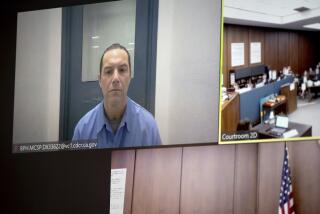DNA Evidence Admissible in Rape Trial : The Law: In a first for San Diego County, a judge has ruled that the new ‘genetic fingerprinting’ technique may be used as evidence in a rape trial.
- Share via
Evidence from so-called “genetic fingerprinting” tests may be admitted in the upcoming trial of a man charged with raping a Pacific Beach woman, a Superior Court judge ruled Wednesday in a first for San Diego County.
Judge William D. Mudd ruled that the novel technique, which examines the genetic marker DNA and can be used, like a fingerprint, to identify a suspect--had already proven so reliable that it met the legal test of being “generally accepted” by forensic experts.
Although genetic fingerprinting evidence has been admitted in other San Diego criminal cases, Mudd’s decision marked the first time a San Diego judge has ruled on the technique after a challenge from an objecting defense attorney.
Since last summer, judges in a number of California counties--including Ventura, Alameda and Orange--also have approved the use of the technique. Judges in at least two states, however, have refused to allow it into court.
William Saunders, the deputy public defender who brought the challenge before Mudd, said after the ruling that he could “not quarrel with it” in light of other approvals around California. Deputy Dist. Atty. Michael Carpenter said he definitely would use the evidence against Barrett Brooke Littleton, 44, of San Diego, whose trial on charges of raping a Pacific Beach woman begins today.
Littleton, in court Wednesday to listen to Mudd explain why the technique was legally acceptable, declined to comment.
Although the use of DNA testing in criminal cases is recent, it has been widely used for years for a variety of other applications involving paternity tests. It involves a complicated chemical process that translates the genetic makeup of tissue into DNA patterns that resemble the familiar bar codes used to price items at the grocery store.
DNA, which stands for deoxyribonucleic acid, is found in the cells of human tissue, such as blood, hair roots or semen. Every person, except for identical twins, has links of DNA that are unique to him or her, and it is those highly variable individual links that provide the basis for “genetic fingerprinting.”
Littleton is charged with two counts of rape as well as oral copulation and burglary in connection with the Sept. 14, 1988, attack on a 24-year-old woman at her Pacific Beach apartment.
Over the course of a lengthy hearing that began in December, Carpenter told Mudd that DNA tests performed after the attack, on stains obtained from the victim’s comforter and from vaginal swabs, excluded the woman’s boyfriend and pointed to Littleton. Saunders claimed that the technique, though promising, had simply not yet proven reliable.
Both sides produced experts at the hearing in subjects such as population genetics and microbiology to duel from the stand over its reliability. In addition, the lawyers gave Mudd a stack of material 4 feet high on the issue, 106 items in all. Mudd said he had read it all.
Mudd rejected a defense contention that there were flaws in the test methods used by Cellmark Diagnostics Corp., the Maryland firm that ran the tests in Littleton’s case, saying he had seen no evidence of that.
Even after proof that the tests were done correctly, the law demands that a new technique be accepted among the experts who perform it before lawyers can introduce evidence of it in court, Mudd said.
After reviewing the voluminous record, the judge said he was convinced that DNA tests had “clearly, clearly” become accepted among forensic scientists.
Mudd also gave Littleton one victory.
Carpenter had said before the hearing began that the odds were 1 in 8,100 that the DNA print the samples yielded were from anyone but Littleton. However, because the states that have barred the evidence have pointed to flaws in the statistical tables used to figure the odds, Carpenter said Wednesday he chose not to present Mudd with those numbers.
So, Mudd ruled, the lawyers cannot use the figures at Littleton’s trial. Carpenter may, however, say that the tests rule out the woman’s boyfriend but do not exclude Littleton, the judge ruled.
Carpenter has said that, although the tests are important, he has other evidence, including the victim’s identifications of Littleton at a photo lineup, a live lineup and at the preliminary hearing.
More to Read
Sign up for Essential California
The most important California stories and recommendations in your inbox every morning.
You may occasionally receive promotional content from the Los Angeles Times.









